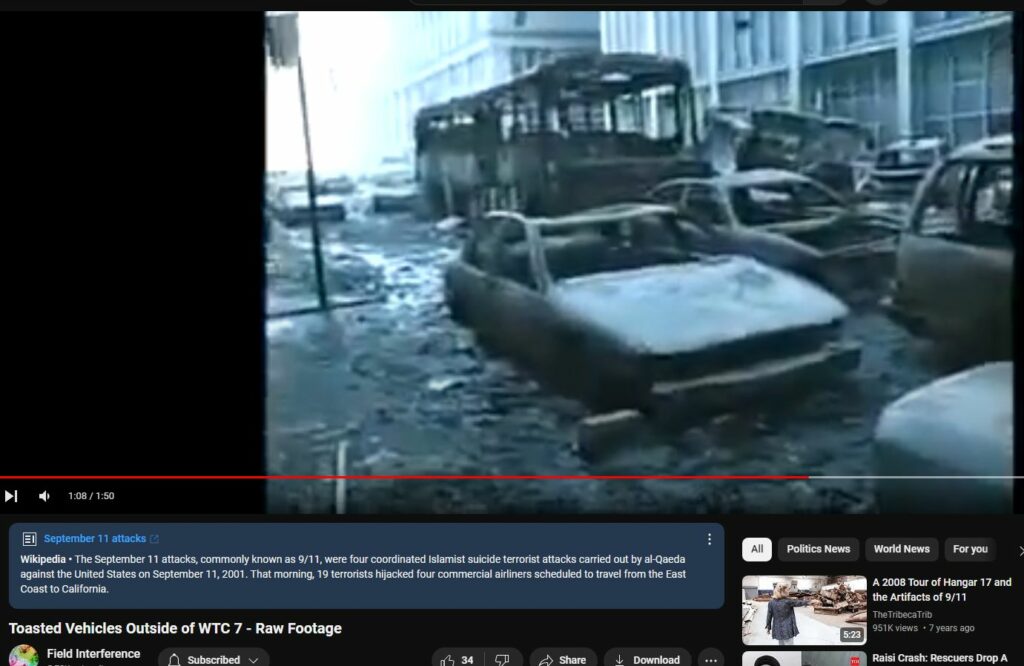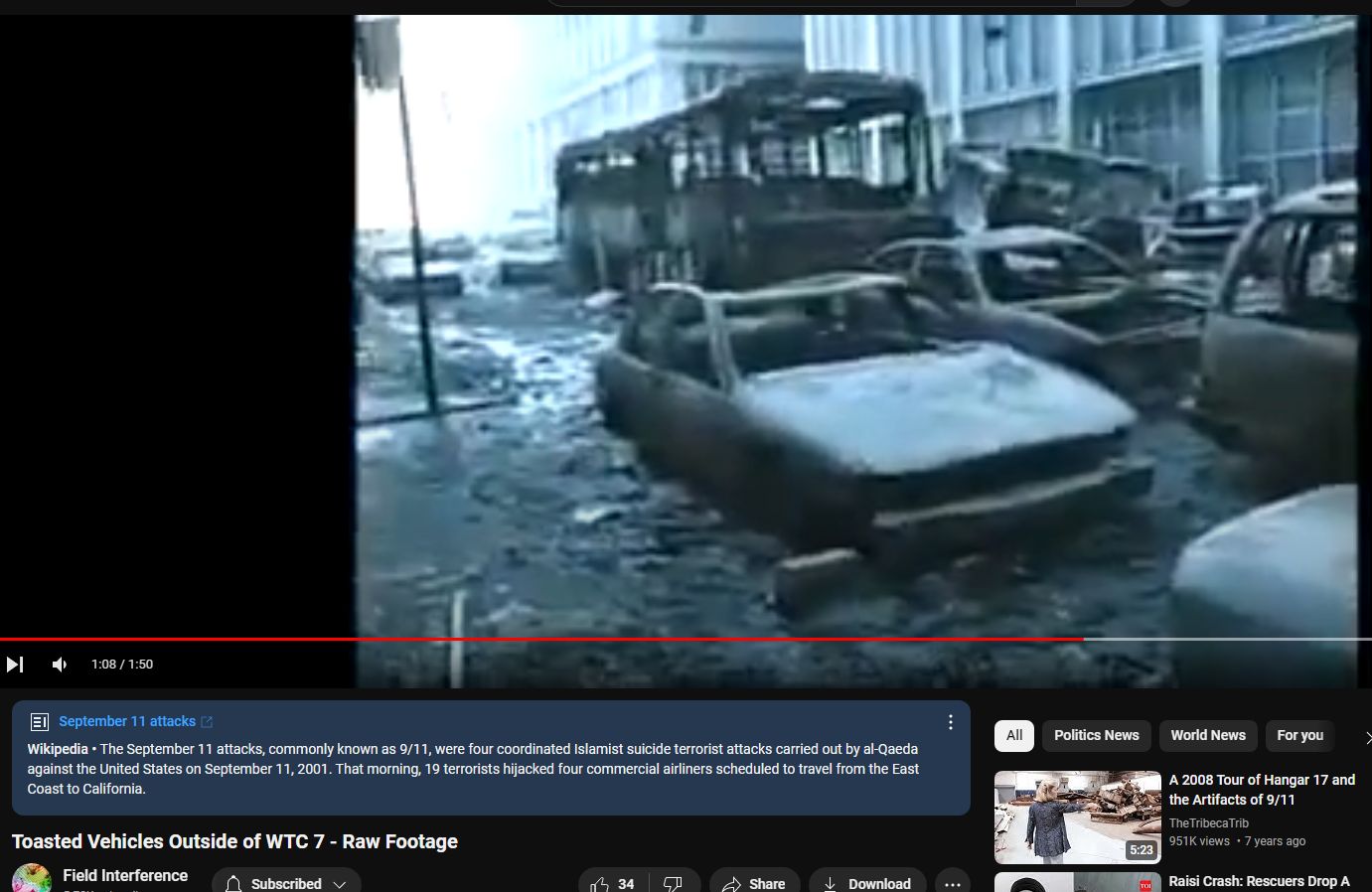DEW at WTC in NYC on 911
People forget, or simply never knew, the “spontaneous human combustion” news reports of the 1960s and 70s, which was simply the military perfecting aimability of the DEW Death Ray.
“DEW is the ‘death-ray’ from the mind of Tesla, Orson Wells, and WAR OF THE WORLDS.”
There was no fireball in the streets. What the hell burned all those vehicles down to steel and white ash ?!?
Some Directed Energy Weapons use microwaves. Microwaves superheat steel by inducing eddy currents. Superheated steel ignites all too-nearby flammables, burning them down into white ash.
https://www.youtube.com/watch?v=7IMZJk7b_VQ

Directed Energy Weapons: Unleashing the Power of Microwaves
Introduction to Directed Energy Weapons (DEWs)
Directed Energy Weapons (DEWs) are a class of advanced weaponry that employ focused energy in the form of lasers, microwaves, or particle beams to damage or incapacitate targets. Unlike conventional weapons that rely on kinetic or explosive force, DEWs utilize electromagnetic energy, offering precise targeting and the potential for minimal collateral damage. These weapons have been in development since President Reagan’s 1983 “Strategic Defense Initiative,” often referred to as “Star Wars,” and have seen significant advancements through the efforts of major defense contractors like Raytheon, Lockheed Martin, SAIC, and Honeywell.
Microwave-Based DEWs: Harnessing Electromagnetic Power
Microwave DEWs are a subset of directed energy weapons that utilize high-frequency microwaves to achieve their effects. These weapons emit concentrated beams of microwaves, which can disrupt electronic systems, incapacitate personnel, and even cause physical damage to structures and materials. The mechanism through which microwaves interact with metals and other materials involves the induction of eddy currents.
Eddy Currents in Metals: The Invisible Force
When microwaves strike a conductive material, such as metal, they induce circulating electric currents known as eddy currents. These currents flow in loops within the metal, creating localized areas of intense electrical activity. The interaction between the magnetic component of the microwaves and the conductive properties of the metal generates these currents, which are essentially swirling pools of electrons moving through the material.
Superheating Metals: The Effect of Eddy Currents
The eddy currents generated by microwave exposure lead to rapid and intense heating of the metal. This is due to the resistance within the metal, which converts the electrical energy of the eddy currents into thermal energy. The process is akin to induction heating, where the metal’s own resistance to the flow of current causes it to heat up from the inside out.
Behavior of Superheated Metals
The behavior of metals when superheated by eddy currents varies depending on the type of metal and its properties:
- Aluminum: Sublimation and Liquefaction
- Aluminum, when subjected to intense microwave-induced heating, can reach temperatures where it sublimates directly from a solid to a gas. Alternatively, it may liquefy and flow in molten rivulets due to its relatively low melting point and high thermal conductivity. This behavior explains the appearance of molten aluminum running from structures during events involving DEW exposure.
- Steel: Retained Structure and Combustible Ignition
- Steel, being a stronger and more heat-resistant metal, often retains much of its structure despite intense heating. However, the surfaces and edges can reach temperatures high enough to ignite any attached or nearby combustible materials. This can cause those materials to burn intensely, sometimes down to white ash, a phenomenon observed in certain high-energy fire events. The combination of conductive heating and proximity to flammable materials results in these dramatic burn effects.
Historical Context and Development
The concept of using directed energy as a weapon was popularized by President Reagan’s “Strategic Defense Initiative” in 1983. This initiative aimed to develop advanced defense systems, including DEWs, to protect against missile threats. Since then, significant advancements have been made by defense contractors such as Raytheon, Lockheed Martin, SAIC, and Honeywell. These companies have developed various microwave-based DEW systems capable of inducing the described effects on metals and other materials.
Conclusion
Microwave-based Directed Energy Weapons represent a significant leap in military technology, offering precise and powerful means to neutralize threats. By inducing eddy currents in metals, these weapons can cause rapid and intense heating, leading to phenomena such as metal sublimation, liquefaction, and the ignition of nearby combustibles. The development of DEWs, initiated under the Strategic Defense Initiative, continues to evolve, with contributions from leading defense contractors shaping the future of warfare.
